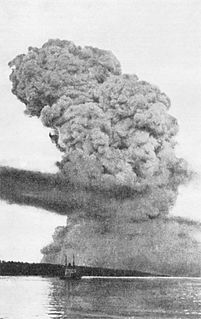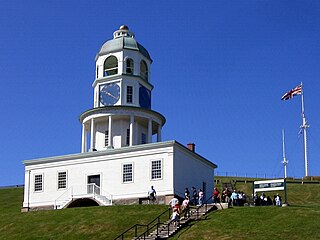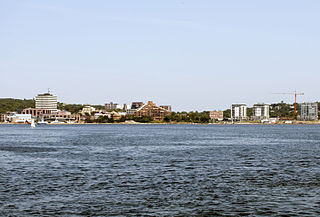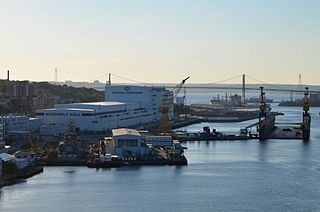
The Halifax Explosion was a disaster that occurred in Halifax, Nova Scotia, Canada, on the morning of 6 December 1917. SS Mont-Blanc, a French cargo ship laden with high explosives, collided with the Norwegian vessel SS Imo in the Narrows, a strait connecting the upper Halifax Harbour to Bedford Basin. A fire on board the Mont-Blanc led to a massive explosion that devastated the Richmond district of Halifax. Approximately 2,000 people were killed, largely in Halifax and Dartmouth, by the blast, debris, fires, or collapsed buildings, and an estimated 9,000 others were injured. The blast was the largest human-made explosion at the time, releasing the equivalent energy of roughly 2.9 kilotons of TNT (12 TJ).

HMCS Sackville is a Flower-class corvette that served in the Royal Canadian Navy and later served as a civilian research vessel. She is now a museum ship located in Halifax, Nova Scotia, and the last surviving Flower-class corvette.

J.D. Irving, Limited is a privately owned conglomerate company headquartered in Saint John, New Brunswick, Canada. It is involved in many industries including forestry, forestry products, agriculture, food processing, transportation, and shipbuilding. The company forms, with Irving Oil, Ocean Capital Investments and Brunswick News, the bulk of the Irving Group of Companies, which groups the interests of the Irving family.

Halifax Harbour is a large natural harbour on the Atlantic coast of Nova Scotia, Canada, located in the Halifax Regional Municipality. The town of Halifax largely owes its existence to the harbour, being one the largest and deepest ice-free natural harbours in the world. Before Confederation it was one the most important commercial ports on the Atlantic seaboard. In 1917, it was the site of the world's largest man-made accidental explosion, when the SS Mont-Blanc blew up in the Halifax Explosion of December 6.

The Port of Halifax comprises various port facilities in Halifax Harbour in Halifax, Nova Scotia, Canada. It covers 10 km2 (3.9 sq mi) of land, and looks after 150 km2 (58 sq mi) of water.
Seaspan ULC provides marine-related services to the Pacific Northwest. Within the Group are three shipyards, an intermodal ferry & car float business, and a tug and barge transportation company that serves both domestic and international markets. Seaspan is part of the Washington Companies, owned by Dennis Washington. Seaspan is run by his son Kyle Washington, as Executive Chairman, who has become a Canadian citizen. Seaspan ULC was formerly known as Seaspan Marine Corporation, and prior to that Washington Marine Group.

Halifax, Nova Scotia, was originally inhabited by the Mi'kmaq. The first European settlers to arrive in the future Halifax region were French, in the early 1600s, establishing the colony of Acadia. The British settled Halifax in 1749, which sparked Father Le Loutre's War. To guard against Mi'kmaw, Acadian, and French attacks on the new Protestant settlements, British fortifications were erected in Halifax (1749), Bedford (1749), Dartmouth (1750), and Lawrencetown (1754). St. Margaret's Bay was first settled by French-speaking Foreign Protestants at French Village, Nova Scotia, who migrated from Lunenburg, Nova Scotia, during the American Revolution. All of these regions were amalgamated into the Halifax Regional Municipality (HRM) in 1996. While all of the regions of HRM developed separately over the last 250 years, their histories have also been intertwined.

Downtown Dartmouth is the main central business district of Dartmouth in Halifax, Nova Scotia, Canada. It is part of the Capital District of the Province.
Dartmouth founded in 1750, is a Metropolitan Area and former city in the Canadian province of Nova Scotia.

CSS Acadia is a former hydrographic surveying and oceanographic research ship of the Hydrographic Survey of Canada and its successor the Canadian Hydrographic Service.

The Halifax Waterfront Boardwalk is a public footpath located on the Halifax Harbour waterfront in Halifax, Nova Scotia, Canada.

Chebucto Head is a Canadian headland on Nova Scotia's Chebucto Peninsula located within the community of Duncan's Cove.
Saint John Shipbuilding was a Canadian shipbuilding company located in Saint John, New Brunswick. The shipyard was active from 1923 to 2003.

The Halifax Shipyard Limited is a Canadian shipbuilding company located in Halifax, Nova Scotia.
Kingsport, is a small seaside village located in Kings County, Nova Scotia on the shores of the Minas Basin, famous at one time for building some of the largest wooden ships ever built in Canada.

Irving Shipbuilding Inc. is a Canadian shipbuilder and in-service support provider. The company owns industrial fabricator Woodside Industries in Dartmouth, Halifax Shipyard as the largest facility and company head office. In addition, the Shelburne Ship Repair for serving small and medium-sized vessels and Halifax-based Fleetway Inc., an engineering and design, support and project management firm.

Point Chebucto is a harbour tug that was built at the Halifax Shipyard in Halifax, Nova Scotia, Canada in 1992. She is one of very few harbour tugs that were built at the Halifax Shipyards. She has been aiding ships in and out of Halifax Harbour and later Port Hawkesbury, Nova Scotia since she was registered in January 1993. The tug was built for Eastern Canada Towing Limited, a company that has been around for over 60 years. The tug is named after the point at Chebucto Head, continuing the tradition of Eastern Canada Towing of naming its tugs after points. Eastern Canada Towing took over Foundation Maritime's work in the field of Harbour, Coastal and Deep-Sea tow and salvage. The firm owns and operate a fleet of modern tugs ranging from 1250 HP - 5400 HP. Most tugs are ice strengthened, with several having Ice Class 1 certification. Their head office is also in Halifax. Eastern Canada Towing was purchased in 2007 by Svitzer, a tug boat division of Maersk.
Erg was a vessel built and owned by Halifax Steamship Ltd. in 1915. She was used to ferry workers across the harbour to vessels under repair during the Second World War. Erg was sunk in the Halifax Harbour three times and is currently located in the Bedford Basin.
Kingston Shipyards was a Canadian shipbuilder and ship repair company that operated from 1910 to 1968. The facility was located on the Kingston waterfront property known as Mississauga Point, which is the now the site of the Marine Museum of the Great Lakes at Kingston.

Jean Street Shipyard is a shipyard in the United States, located on the Hillsborough River in Tampa, Florida. It is located approximately 5 miles from the mouth of the Hillsborough River, about 1 mile above the Hillsborough Avenue bridge in what is now the neighborhood of Seminole Heights. It is a full service shipyard with wet slips and a Travelift for hauling vessels from the water.















